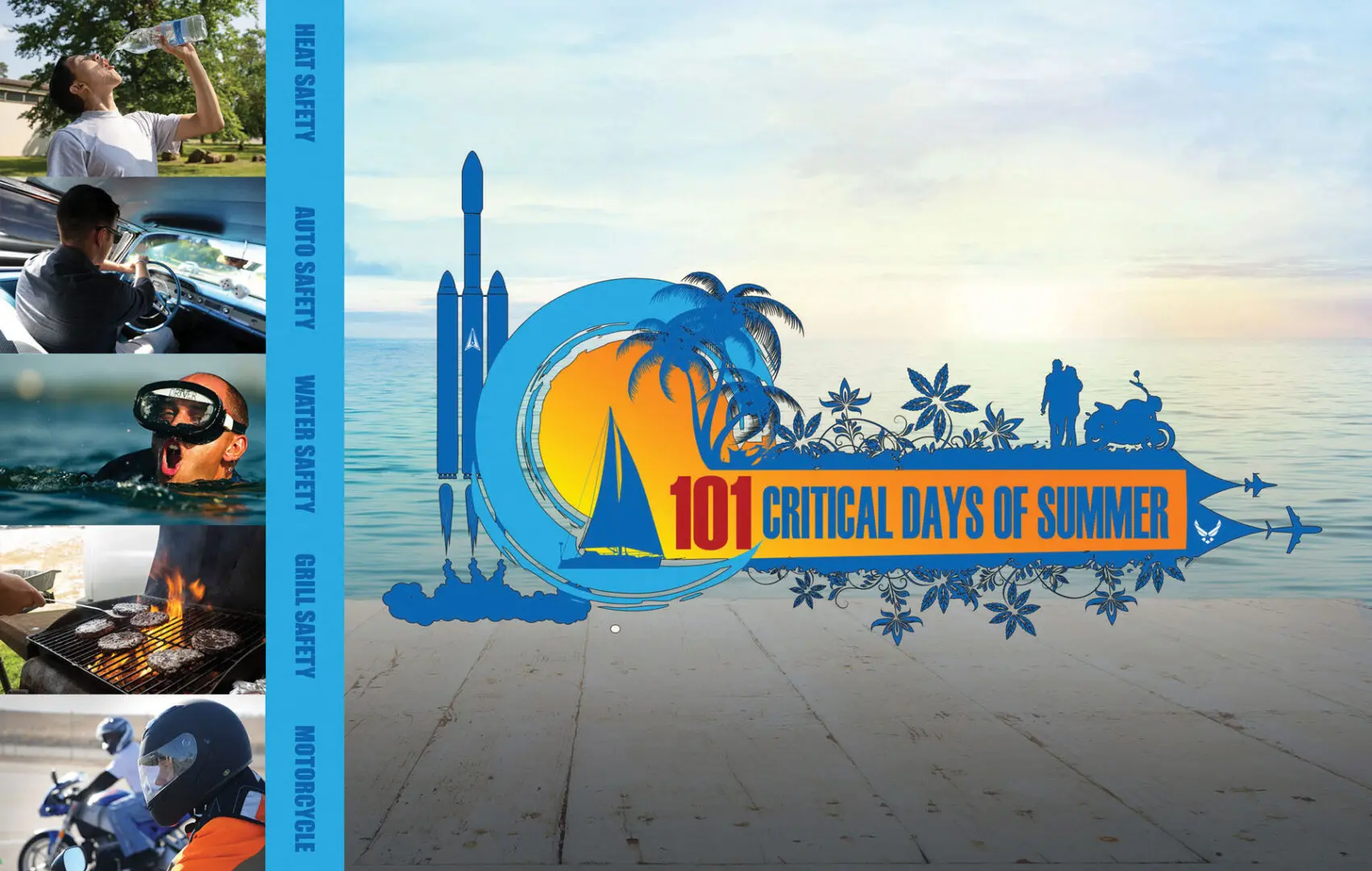101 Critical Days of Summer: Fun in the Sun!
By Ms. Lisa Gonzales, Air Force Safety Center
Summer is the time to enjoy warm, sunny days safely. The 101 Critical Days of Summer (101 CDS) focuses on preventing the annual spikes in injuries and accidents between Memorial Day and Labor Day. For the Department of the Air Force (DAF), these accidents not only impact individuals and their families but also mission readiness and force lethality.
DAF saw an increase in injuries during 101 CDS in 2024, amounting to 1,477 injuries, up from 1,425 in 2023. Over the past six years, DAF has seen a slight decrease in overall injuries and accidents; however, the number of injuries is still more than zero, and the use of risk-informed decision-making in all summertime activities will help prevent unnecessary injuries or accidents.
The risks associated with summertime activities can be avoided by performing a risk assessment beforehand (or taking a risk management refresher course if you have not completed one in some time). Start by making a list of essential items that you will need for the activity. At a minimum, the list should include an emergency medical kit with medications and first aid supplies, plenty of water or drinks containing electrolytes, and food high in potassium and protein if the activity is strenuous. Remember to never leave Mother Nature up to chance when gathering supplies and prepare for the unexpected.
When it is time to have fun, wear sunscreen with an SPF of thirty or higher when out playing in the sun or the water, as the sun’s ultraviolet rays reflect off the surface and can damage the skin. Using sunscreen will help prevent sunburn or other skin conditions. According to the National Cancer Institute,[1] skin cancer, also known as melanoma, will have an estimated 100,640 new cases in 2024. Therefore, use sunscreen lotion, not forgetting the top of your ears and nose.
For similar reasons, consider using sunglasses that protect from ultraviolet A (UVA) or ultraviolet B (UVB). Such glasses have an ultraviolet (UV) rating of UV400 to protect the eyes from the sun’s UV rays. According to the National Eye Institute,[2] UVA and UVB rays can cause multiple eye problems such as early cataracts, pinguecula, and pterygium.
When engaging in strenuous physical activity outdoors, such as playing sports in the sun, take frequent breaks to cool down and hydrate with water or drinks that contain electrolytes. Avoid caffeinated or alcoholic drinks as they have a dehydrating effect on the body. Be sure to know the symptoms of heat exhaustion or heat stroke and how to treat them. Call 911 and move them to a cooler place if you notice someone in heat distress. Try to lower their body temperature with cool cloths or a cool bath. While waiting for first responders to arrive, continue to cool their body down; do not give the person anything to drink.
Another summertime favorite is swimming or playing games (e.g., Marco Polo) in the ocean to cool down. When doing so, be cautious as rip currents—powerful, narrow channels of fast-moving water that move away from the shore—can form without warning. According to the National Weather Service,[3] rip currents cause more than one hundred drownings at the beach each year in the United States. If caught in a rip current, swim parallel to the shore to escape it, and never swim alone.
Moreover, as the days get longer, the desire to head into the great outdoors and take a long-anticipated motorcycle ride grows, as does the desire for camping or hiking. Before venturing out, plan for the unexpected, as the weather can change in the blink of an eye. To prepare, make a list of weather-related items you will need, such as blankets, jackets, food, and water. Once plans for your outing are set, share them with family and friends.
Hiking can be strenuous, depending on where you hike or if the hike will be overnight. If the plan is an overnight hike, headlamps, water filtration devices, light layers of clothing, a tent, a sleeping bag, and foods high in protein should be on the list. Plan out your trip by making a map of the area you will be. Hiking poles can help with your balance and stability in the steep ascents or descents and help protect the knees. Stretch out muscles to warm them up before and after the hikes. Stretching before strenuous activities can help you stay limber and free of injury.
Before taking that first motorcycle ride, be sure to check the weather and road conditions and conduct a T-CLOCS check on your motorcycle to ensure its parts are working correctly:
Tires and wheels
Controls
Lights and electrics
Oil and other fluids
Chassis
Stand
Once the motorcycle is ready for the road, verify the riding gear you will need, such as a helmet, gloves, long-sleeve shirt or leather jacket, pants, and over-the-ankle boots. For additional safety gear, consider packing rain gear and an airbag vest.
The avid mountain biker will need bike supplies, personal protective gear, and riding gear that covers weather changes. Biking tools should include an air pump with several needles, gear adjustment tools, and extra tubes or slime to fix a flat tire.
“Summer is a time to relax and have fun in the sun, but do it responsibly by incorporating risk management in[to] all your summertime activities,” said William “Bill” Walkowiak, Chief of Occupational Safety at the Air Force Safety Center. “Risks are in everything we do, so this summer, before you start an activity, do a risk assessment to help lower the risks involved for a safer summer.”
For additional information on 101 CDS, visit:
https://www.safety.af.mil/Divisions/Occupational-Safety-Division/Summer-Safety/.
[1] National Cancer Institute. 2022. Cancer Stat Facts: Melanoma of the Skin. https://seer.cancer.gov/statfacts/html/melan.html.
[2] National Eye Institute. n.d. Protecting Your Eyes From the Sun’s UV Light. https://www.nei.nih.gov/about/news-and-events/news/protecting-your-eyes-suns-uv-light.
[3] National Weather Service. n.d. NOAA and USLA Rip Current Safety Toolkit. https://www.weather.gov/safety/ripcurrent-toolkit.

